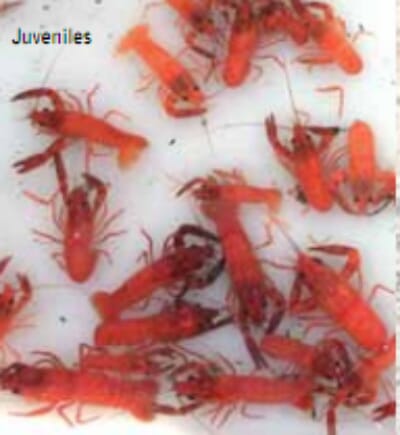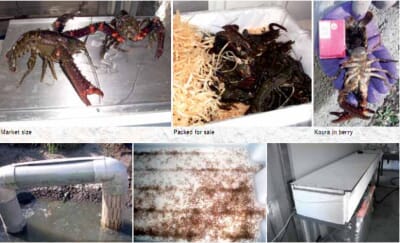Pieter Wilhelmus established New Zealand Clearwater Crayfish in 1996. Here he writes for NZ Aquaculture.
I started farming in 1993, just after moving to Marlborough with a number of years of freshwater salmon farming under my belt and keen to have my own freshwater fish farm. We found a suitable site up the Wairau Valley and began the paperwork war to establish a salmon farm. I didn’t want to have all my eggs in one basket, so, enter the koura. I had caught these as a child, having fun and a good feed at the same time.
So I decided to set up an aquarium trial in our shed in the middle of town to see how they would breed. The tank was about half a cubic metre in size and had an artificial cover, plus natural weed for food and cover. I collected three males and three females, put them in the tank and left them to it. I fed them worms and salmon food, and the natural weed was also available for them to eat. Twelve months later I had so many hatchlings it wasn’t funny, so I had to end the experiment.
By March 1995 we had a small salmon farm built and fish in the water. At that time David Smythe, who had done our consent work for the farm, said if I wanted a partner to help get the koura farm going to give him a ring. So it was that New Zealand Clearwater Crayfish (Koura) Ltd was set up to help grow and market the Paranephrops planifrons that Ormond Aquaculture Ltd had started. The first trials were very basic, using some large plastic tanks, just to establish growth rates and survival in the first 12 months. These were only partially successful, as the growth rates were good but the survival rates were affected by cannibalism.

We determined that koura needed lots of room and a lot of cover. Two races were dug out in the natural gravel and compacted to stop most of the water loss to ground. Water was supplied by gravity, just like a flow-through salmon farm. The races were left for 12 months to become just like a natural stream, with lots of weed and grass cover, before being stocked.
Over the next few years we had to find the best way to grow koura. We started by leaving things natural and relied on natural recruitment and harvesting what was ready each year. The system worked okay, but we weren’t getting enough fish of market size coming through, and it was taking a lot of time to select these fish from the others. The system had to change, so we decided to have separate classes for each year. For this to happen we had to have a separate pond for broodstock.
Over the next six years we did three different trials, ranging from using a hatchery to get juveniles to stock races with females in protected baskets to hatching out young directly into predator-free races. This gave us the chance to selectively breed for growth and colour. We have now settled on a system of hatching out fish into dedicated rearing races until they are 12 months old. These are graded out to grow on for another two years or more in larger races. Our outdoor hatchery is still used to hatch out selectively bred crosses, and the tanks also double for mating selective crosses for colour and growth. Koura moult and grow fastest in their first year, and this gave us somewhere to start improving growth.
Koura start breeding in mid-March and hatchlings start appearing in mid-November onwards, depending on how cold the winter is. If we could get the hatchlings out in early September we could get three or four months of extra growth in the first year. A trial was started in an aquarium to artificially incubate koura eggs. It was a pretty simple set-up. A tank was insulated and heated to a selected temperature. The koura eggs were acclimatised slowly to the higher temperature and kept in the dark, with regular water tests done to check on the water quality. To our surprise, the eggs hatched in two months, a full three months ahead of eggs kept in ambient water temperature.
A full-size hatchery had to be built in the following year, but in what? Unfortunately in 2008 we lost all our salmon due to stock pollution of our water supply, which had been an ongoing problem for some years. Thankfully the council did something, though they left it a bit late, and the pollution did not effect the koura. This left us nearly bankrupt but with a lot of surplus ponds and gear. One of our salmon hatching troughs was fully insulated and installed in our disused processing shed. An insulated bulk fish bin was installed in the roof for a head tank, and a collection tank installed under the salmon trough with a submersible pump on a float switch to collect the water and recycle it back to the head tank.
I would like to thank Brent Pickering for his input into the technical details of recirculating systems. The whole system is gas-heated on a thermostat, which also adds fresh water several times a day. We now start the indoor hatchery at the beginning of July and have the hatchlings out in in the races at the beginning of September. When the fry start leaving the females we collect them every four days and bulk weigh them on micro-scales to obtain the numbers by average weight. These are then stocked at 50 per m2 in the one-year races. The survival rate is 97 per cent to stocking out. We now also keep male and female broodstock separate in our disused salmon ponds.
A result of selectively breeding fish is the different colour variations that come through. As black or olive green is not a very good marketing point we decided to work on this. About six years ago I got a real surprise one day while grading a yearling race to see five bright red fish about 50mm in length. I treated these like royalty but, as Murphy’s Law would have it, I lost all five one way or another and thought, that was that.
Two years later, 32 more appeared again. I kept these separate until they reached breeding size. Last year I bred these back across each other and had one small female get in berry. She was kept aside to hatch out her eggs undisturbed. As a result, last spring all her offspring were red. I still don’t know which fish will produce red offspring from standardcoloured fish, but I know I have produced fish with a red gene. Last year I had 60 red fish from standard-coloured fish and now I have 200 red fish and 16 large red females in the hatchery. I am hoping for all red offspring, but three percent of red juveniles revert back to brown.
As far as I know we have the only fully red freshwater crayfish in the world. These fish really turn heads in the marketing sector and could easily compete with scampi and the like. I guarantee the photographs published with this article are the real thing, the koura are not colourfed and there have been no genetic experiments. The red colour is natural, like any other farmer would do to get a particular trait. We hope to have commercial numbers in a few years.
The farm is producing two tonnes/ha equivalent, with a gross return of $55,000 to $60,000 per tonne, plus freight and so on. Running costs vary, depending on how much artificial food is used. I developed a special diet and it is fed as a supplementary ration to boost their natural diet. Predators were a big problem at the start, with numerous races of koura lost to eels. It took several prototypes before I came up with what you see in the photograph. This still allows us to use an up-stand to control water depth, but also incorporates a trap for fish and to draw stale water from the bottom of the race.
We use 3mm slots on the grow-out races and 1mm slots on the hatchling races to stop the hatchlings from migrating out. The screens seldom become blocked and the screened and horizontal sections can be removed to let frog weed flow out without lowering the water level. Work needs to be done on identifying the gene for fast growth and the production of single-sex specimens to speed up growth rates. Just remember, all you would-be aquaculture folks out there. Don’t believe what you hear until you try it.


